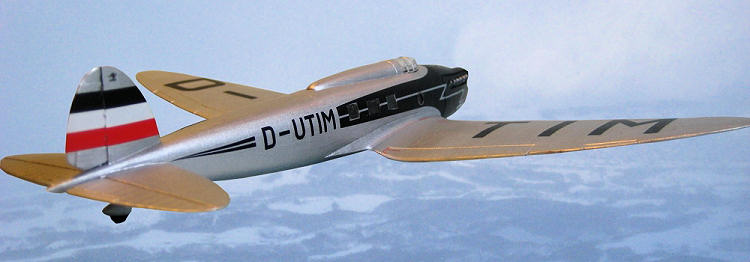
| KIT #: | 04229 |
| PRICE: | HK$ 45.00 |
| DECALS: | Three options |
| REVIEWER: | Richard F |
| NOTES: | Reboxed Matchbox kit. Actually, Revell bought the company so it isn't odd that they'd release it. |

| HISTORY |
Sitting in the tail end of
a packed China Eastern A330 the other day, stuck for an hour in a taxiway
traffic jam while our plane spewed gas into Beijing's already thick air, I was
compelled to think of the more glamorous early years of flying. Having just
finished this model the night before, my mind didn't have to wander far.
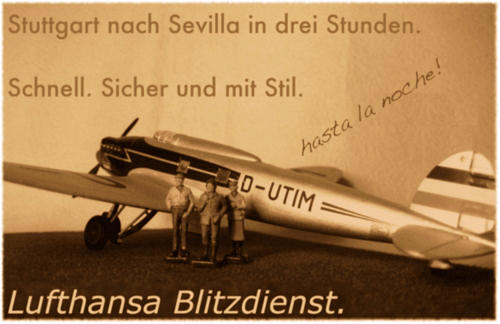 The
swish-looking Heinkel He-70 deserved its nickname "Blitz" (Lightning).
Speedy right from its first flight in 1932, it set eight records with a top
speed of 377km/h – very fast in those days. The RAF's Bristol Bulldog, one
of its main fighters of the early 1930s, could only manage 287km/h. Even the
Hawker Fury, ordered in to supplement the Bulldog, as reviewed recently by Tom
Cleaver, could only reach 360km/h.
The
swish-looking Heinkel He-70 deserved its nickname "Blitz" (Lightning).
Speedy right from its first flight in 1932, it set eight records with a top
speed of 377km/h – very fast in those days. The RAF's Bristol Bulldog, one
of its main fighters of the early 1930s, could only manage 287km/h. Even the
Hawker Fury, ordered in to supplement the Bulldog, as reviewed recently by Tom
Cleaver, could only reach 360km/h.
The Heinkel was certainly a lot faster than the taxi-way at Beijing Capital
Airport. When the captain told us we'd be waiting even longer before
take-off, I started thinking about the flights I could have taken with Lufthansa
in the mid-30s – with only three fellow passengers instead of several hundred;
glamorous 30s types rather than bulk tour groups; a quick flight from Stuttgart
to Seville or from Cologne to Berlin. I could have dinner with Marlene
Dietrich and be in Seville the next day for cocktail hour with Ernest Hemingway,
even as the clouds of civil war grew on the horizon (and the Legion Condor's own
He-70s swung overhead).
Well, that's the backstory to my model, even if it takes just a few liberties
with the historical truth. It was a nice distraction from cattle class. Of
course, knowing me I'd have been terribly airsick bouncing around in the back of
the tiny He-70 – there is something to be said for cruising in an Airbus at
30,000 feet, once you finally do get off the ground. But in the spirit of these
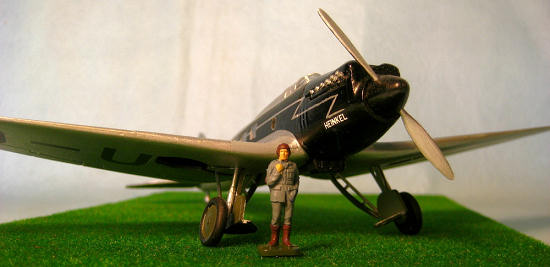 thoughts, I added some figures to my display – a laconic pilot and two glamorous
liveried stewards, and a 1930s photographer to advertise the "Lightning Service"
to Seville.
thoughts, I added some figures to my display – a laconic pilot and two glamorous
liveried stewards, and a 1930s photographer to advertise the "Lightning Service"
to Seville.
You can read more about the He-70 in the previews, but it is well-known to
Luftwaffe buffs as the predecessor to the He-111, and for the debate about who
really invented the elliptical wing it has in common with the Spitfire and the
Val. The Blitz was actually designed as a mailplane, and flew airmail from
Germany to Spain as part of the first transatlantic airmail service. After
being dropped in Spain by the Blitz, the mail went across the Atlantic in
Dornier Wal flying boats. As a combat aircraft, the He-70 was not too
successful. Apparently, its fuselage was constructed from a highly flammable
magnesium alloy that would erupt in unquenchable flames from the impact of even
a single bullet. The Hungarians quickly retired their fleet in favour of an
older type. Still, it saw service in the Spanish civil war and the very early
days of World War II.
| THE KIT |
This Revell kit started life as a Matchbox kit. Both have been reviewed here on
Modeling Madness: Revell:
http://www.modelingmadness.com/scotts/axis/previews/revell/04229.htm.
Matchbox:
http://www.modelingmadness.com/scotts/preww2/he70preview.htm.
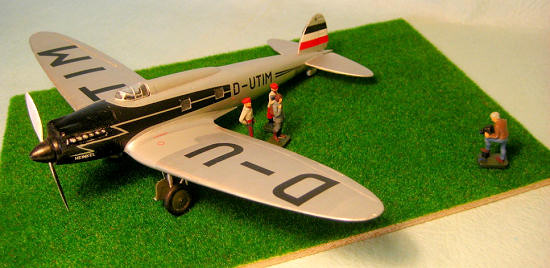 Both kits provide the same three versions but with slightly different markings.
There's the streamlined He-70G, used by Lufthansa; the He-70F-2, with a rear
gunner, used by the Legion Condor; and the less-attractive He-170A (aka He-70K)
with a rear gunner and a stumpy radial engine, built under licence and flown by
Hungary.
Both kits provide the same three versions but with slightly different markings.
There's the streamlined He-70G, used by Lufthansa; the He-70F-2, with a rear
gunner, used by the Legion Condor; and the less-attractive He-170A (aka He-70K)
with a rear gunner and a stumpy radial engine, built under licence and flown by
Hungary.
Nicely moulded, though not to the most modern standards, the kit has raised
panel lines and average detail. The small cockpit comes with a control stick
and instrument panel that are more or less invisible once the window is
installed. The main cabin includes two passenger couches, and there would be
lots of scope for detail work here if you left the fuselage roof open or made it
somehow removable. Unless you do that, though, it is very difficult to see
inside.
| CONSTRUCTION |
First things first.
And no, that doesn't mean the cockpit! First of all you need to decide which
version to build. The sleek He-70G mail plane, depicted on the box art; the F-2
bomber version of that model, which has a rear gun position; or the 170A radial-engined
version with the rear gun position and (to my eyes) the impossibly ugly fat
nose. Once you decide, it's on to the simple cockpit and cabin area. The two
cabins could use lots of interior detail, but as noted, the cabin windows are
small and it's hard to see anything in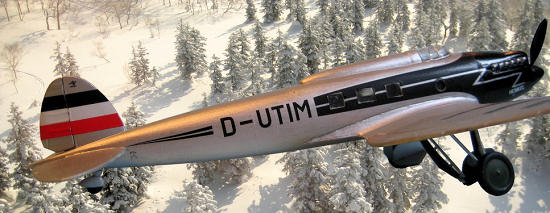 side. I built these straight from the
box.
side. I built these straight from the
box.
Be sure to check whether your version requires the window in the bottom of the
fuselage. The passenger version does not need this window. Had I realised this
earlier, I would have smoothed over that cavity because the decal didn't fit so
well over that area with the window installed. I only discovered this after
painting the whole plane and completing most of the decals.
The fit of this kit is not bad, but it is not great either. It needed quite a
bit of filler underneath the fuselage where the wings are attached, and where
the engine housing joins the fuselage. I didn't get a fully satisfactory result
here, but I did get the top of the fuselage looking nice, and that's what I'm
going to see when I look at the model on the shelf. There is also a little
filler needed to smoothly attach the fuselage roof (for want of a better
description).
The main undercarriage caused me a lot of trouble. It is quite delicate and one
leg kept wilting. It's not as structurally sound as it could be, so be patient
and take your time. Check for the proper tail undercarriage according to your
version. The instructions called for the skid for the mailplane version, but
pictures I saw on the internet clearly showed the tailwheel, so that's what I
used.
| COLORS & MARKINGS |
The kit includes markings
for three different aircraft. I've already mentioned how ugly one of them is,
but the markings are there for those who want a Hungarian 170A. Slightly more
appealing is the F-2 version, with markings for the Legion Condor in Spain
during the civil war. Probably most popular, certainly based on other builds on
the internet, is the natural metal G version used
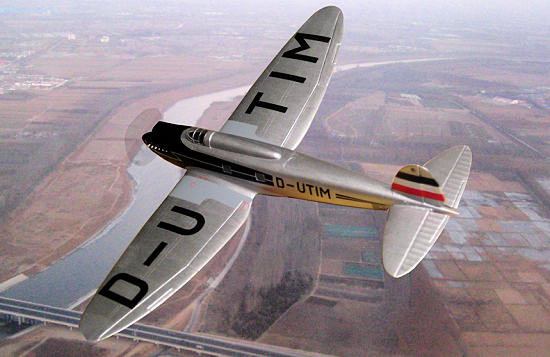 by Lufthansa. The kit's
markings are for a plane used before the Nazis took over Germany, and it has the
tail colours of the Weimar Republic rather than the swastika of the Nazis.
by Lufthansa. The kit's
markings are for a plane used before the Nazis took over Germany, and it has the
tail colours of the Weimar Republic rather than the swastika of the Nazis.
I hand-painted my Blitz with Tamiya XF16 Flat Aluminium acrylic, and X2 gloss
black at the nose.
The decals adhered nicely and are well printed. The only problem area is in the
lightning strip at the nose. It looks like the decal contains both black and
silver, but in fact the instructions call for a silver strip to painted in on
the nose. The black part of the decal then masks out the unwanted silver,
leaving a nice silver stripe. I realised this too late, and ended up ditching
the decal completely and hand-painting the stripe afterwards. On reflection,
this worked better anyway, because the black part of the decal was not as glossy
as the paint on the nose section. It would have been quite noticeable.
As mentioned, I added a few figures, all from Airfix's RAF ground crew set.
There is a pilot and two stewards, in imaginary uniforms. There is also a
photographer, who instead of loading that reconnaissance camera into a Spitfire
is now using a large format camera to photograph the plane and its crew as part
of an advertisement for the Lightning Service "Blitzdienst" from Stuttgart to
Seville - the one I wished I was one when I was stuck in the Airbus as described
above. All this is fictional, but fun.
| CONCLUSIONS |
This is a nice kit of a great looking aeroplane (unless you make the ugly Hungarian one, in which case it is a nice kit of a pretty ugly aeroplane). It took a little skill to get the airframe looking reasonable, but nothing difficult. Anyone should be able to get a decent model out of this. Younger kids might struggle a bit with the finicky landing gear but otherwise there are not many small parts.
February 2009
Copyright ModelingMadness.com. All rights reserved. No reproduction in part or in whole without express permission.
If you would like your product reviewed fairly and quickly, please contact me or see other details in the Note to Contributors.